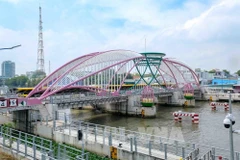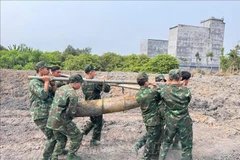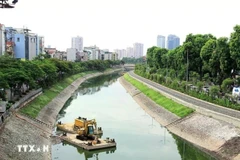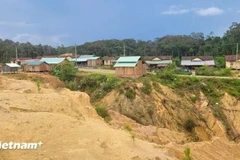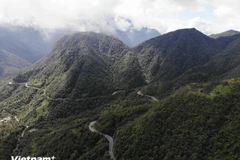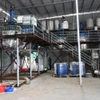The damage was estimated to be 74 trillionVND (3.5 billion USD) during 2008-2012, according to the CentralCommittee for Flood and Storm Control.
Deputy Minister ofAgriculture and Rural Development and Deputy Chairman of the CommitteeHoang Van Thang said “the poor implementation of infrastructureconstruction plans to mitigate natural disasters to the reason for theincrease.”
According to the committee, standards for buildinginfrastructure in flood-and-storm prone areas were issued but had failedto adapt to climate change that caused a negative impact on the areas.
Vice-Chairmanof the National Search and Rescue Committee, Lieutenant General TranQuang Khue said that a village of northern mountainous Lao Cai provincewas swept away by flash flood in 2008.
But no damage was reportedfor Chinese villages nearby, he said, adding that it was believed thatChina had build bridges and drains to manage floodwater.
“Theprogramme to reduce and mitigate natural disasters should regulate thatinfrastructure built for socio-economic development must meet disasterstandards,” he said. Transport works should not be obstacles to drainingfloodwater and hydropower plants should not be obstacles to irrigatecrops, he said.
Nguyen Xuan Dieu, a member of the CentralCommittee for Flood and Storm Control, said road construction in somelocalities hadn’t taken account of dykes and drainage systems and viceversa.
For example, dyke systems in the provinces of Bac Ninh,Hung Yen, Phu Tho and Vinh Phuc have been broadened to serve demands, hesaid.
And the provinces dyke systems connect with Hanoi’sdyke system which hadn’t been expanded, leaving it prone to flooding, hesaid.
Also, Khue said, most houses in the central region were not strong enough to withstand floods and storms.
Dyke construction from northern Quang Ninh province to central Quang Nam province was behind scheduled, he said.
Thecommittee warned that the provinces would face serious consequences dueto climate changes if they failed to finish their dykes as scheduled.
Lossesfrom natural diseases since the beginning of the year have costsouthern Soc Trang province 67 billion VND (3.3 million USD) loss,officials have estimated.
The Mekong Delta province has sufferedsignificant soil erosion recently, affecting more than 6,000 hectares ofrice paddies, landslides and other unusual weather patterns.
Thesteering committee of flood and storm prevention of Ke Sach districthas asked village and commune authorities in the district, one of themost affected areas due to its location near the Hau River , toconsider relocating vulnerable households.
Ke Sach DistrictPeople’s Committee Deputy Chairman Huynh Anh Dung said authorities werealso looking at increased inspections of waterway vessels, with a viewto adding emergency rescue equipment and rechecking important dykesection.-VNA
